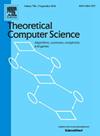Computable formal contexts
IF 1
4区 计算机科学
Q3 COMPUTER SCIENCE, THEORY & METHODS
引用次数: 0
Abstract
This paper studies effective aspects of mathematical structures in formal concept analysis from the standpoint of computability theory. Firstly, we consider the notion of formal concepts of formal contexts and prove that the first and second derivation of a subset of objects of a computable context are - and -complete, respectively. Secondly, we examine the complexity of two representative processes in finding reductions of a context. To study the complexity of the process of merging objects with the same object intents of a context, we define a natural equivalence relation on objects of the context and show that the object equivalence relation of a computable context is -complete. We directly formalize the other process of removing reducible objects of a context via reducible objects themselves and prove that the set of reducible objects of a computable context is -complete. The down-left arrow relation is a useful tool to find reducible objects of a context. Lastly, we show that the arrow relation of a computable context is -complete. By dealing with dual contexts, we obtain the same complexity results on corresponding structures based on attributes of contexts.
可计算的形式语境
本文从可计算性理论的角度研究了形式概念分析中数学结构的有效方面。首先,我们考虑了形式上下文的形式概念的概念,并证明了可计算上下文对象子集的一阶导数和二阶导数分别为Π10-和Π20-complete。其次,我们研究了寻找上下文还原的两个代表性过程的复杂性。为了研究上下文中具有相同对象意图的对象合并过程的复杂性,我们定义了上下文对象的自然等价关系,并证明了可计算上下文的对象等价关系为Π10-complete。我们通过可约对象本身直接形式化了另一个移除上下文可约对象的过程,并证明了可计算上下文的可约对象集合为Π30-complete。左下箭头关系是查找上下文中可简化对象的有用工具。最后,我们证明了一个可计算上下文的箭头关系是Π20-complete。通过对偶上下文的处理,我们基于上下文的属性在相应的结构上得到了相同的复杂度结果。
本文章由计算机程序翻译,如有差异,请以英文原文为准。
求助全文
约1分钟内获得全文
求助全文
来源期刊

Theoretical Computer Science
工程技术-计算机:理论方法
CiteScore
2.60
自引率
18.20%
发文量
471
审稿时长
12.6 months
期刊介绍:
Theoretical Computer Science is mathematical and abstract in spirit, but it derives its motivation from practical and everyday computation. Its aim is to understand the nature of computation and, as a consequence of this understanding, provide more efficient methodologies. All papers introducing or studying mathematical, logic and formal concepts and methods are welcome, provided that their motivation is clearly drawn from the field of computing.
 求助内容:
求助内容: 应助结果提醒方式:
应助结果提醒方式:


